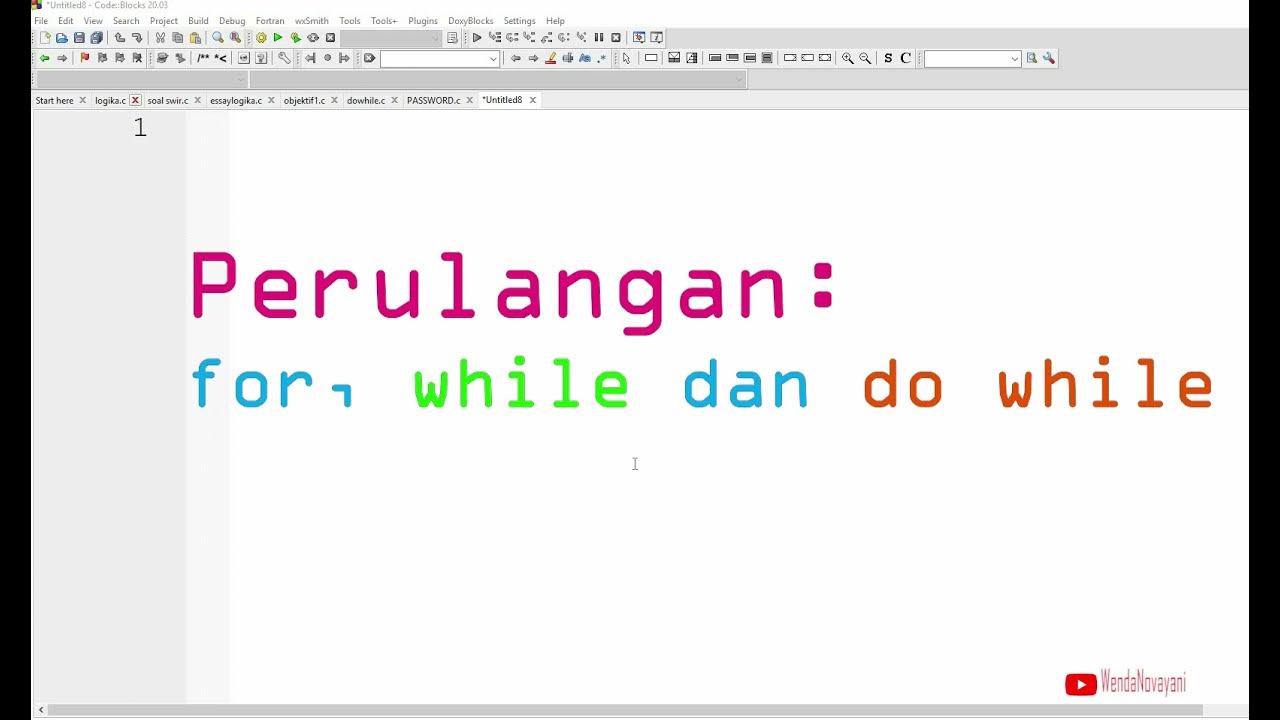#42 Belajar Perulangan For C++
Summary
TLDRIn this video, the presenter explains the concept of loops in programming, specifically focusing on the 'for' loop in C++. The presenter uses relatable analogies, such as a student being punished to write a sentence 100 times, to introduce the idea of repetition in code. The video breaks down the syntax of the 'for' loop, showing how initialization, condition checking, and increment/decrement work together. It also explores nested loops and provides examples with flowcharts to aid understanding. The tutorial is designed to help beginners grasp basic looping concepts and their practical applications in programming.
Takeaways
- 😀 The video introduces the concept of loops in programming, specifically focusing on the 'For Loop' in C++.
- 😀 Loops allow for the repetition of commands or instructions until a specific condition is no longer true.
- 😀 An example is given using a student writing a sentence 100 times as a punishment, illustrating how a loop works.
- 😀 A 'For Loop' helps avoid repetitive code by executing a block of code multiple times, saving memory and time.
- 😀 The syntax of a 'For Loop' consists of three main parts: initialization, condition, and increment/decrement.
- 😀 Initialization sets the starting value of a variable, usually a counter like `int i = 0;`.
- 😀 The condition is evaluated each time the loop runs, and if it's true, the code inside the loop is executed.
- 😀 The increment/decrement operation modifies the loop variable after each iteration, such as `i++`.
- 😀 An example of a 'For Loop' is provided, printing numbers from 1 to 5 using simple syntax.
- 😀 Flowcharts are used to visualize the logic behind a 'For Loop', demonstrating its continuous checking of conditions and execution.
- 😀 Nested 'For Loops' are introduced, showing how one loop can be placed inside another to handle more complex tasks like iterating over rows and columns.
- 😀 The video concludes by encouraging viewers to ask questions in the comments, aiming to assist beginner programmers with understanding loops.
Q & A
What is the main topic discussed in the video?
-The main topic of the video is the concept of loops in programming, specifically the 'for' loop, in the context of C++ programming.
What is a loop in programming, as explained in the video?
-A loop in programming is a process where a statement or command is executed repeatedly as long as a specified condition is true.
What are the three types of loops mentioned in the video?
-The three types of loops mentioned are 'for', 'while', and 'do-while'.
Can you explain the analogy used to explain the 'for' loop?
-The analogy involves a student who is late to school and is given the task of writing a sentence ('I promise not to be late again') 100 times as punishment. The 'for' loop works like this, repeating a task until a condition (writing 100 times) is met.
What is the purpose of using a 'for' loop in programming?
-The purpose of using a 'for' loop is to avoid writing repetitive code. It allows the program to execute a task multiple times without needing to manually write the same line of code multiple times.
What are the three main components of the 'for' loop syntax in C++?
-The three components are: initialization (where the variable is defined), condition (which checks if the loop should continue), and increment (which updates the variable to eventually meet the stopping condition).
How does the 'for' loop operate in the example of printing 'I promise not to be late' five times?
-The loop starts with 'i' initialized to 0, and the condition checks if 'i' is less than 5. The loop prints the sentence, increments 'i' by 1, and repeats the process until 'i' equals 5.
What happens when the loop condition in a 'for' loop becomes false?
-When the loop condition becomes false, the loop stops executing, and the program moves on to the next part of the code.
What is a 'nested for' loop?
-A 'nested for' loop is a loop inside another loop. The outer loop runs first, and for each iteration of the outer loop, the inner loop runs repeatedly until its own condition is met.
What is the flowchart used for in the video?
-The flowchart is used to visually represent the process of how a 'for' loop works, showing how the condition is checked, how the task is executed, and how the loop continues or exits based on the condition.
Outlines

This section is available to paid users only. Please upgrade to access this part.
Upgrade NowMindmap

This section is available to paid users only. Please upgrade to access this part.
Upgrade NowKeywords

This section is available to paid users only. Please upgrade to access this part.
Upgrade NowHighlights

This section is available to paid users only. Please upgrade to access this part.
Upgrade NowTranscripts

This section is available to paid users only. Please upgrade to access this part.
Upgrade Now5.0 / 5 (0 votes)





